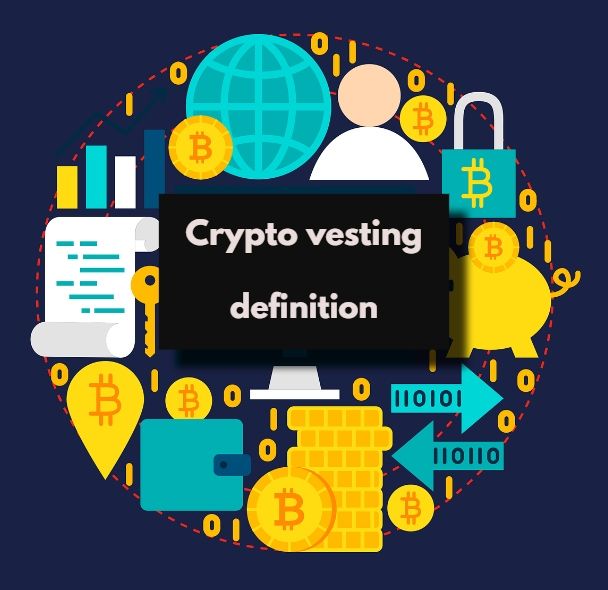
Crypto vesting: definition. A Key Mechanism for Aligning Interests. Find out what it is and what it does with examples.
Crypto vesting: definition and exemples. The world of cryptocurrency is often complex and ever-evolving. One of the essential financial mechanisms in this domain is vesting. This relatively technical term refers to a crucial process for managing tokens and aligning the interests of stakeholders. In this article, we will explore in detail what vesting is, how it works, and why it is important in the cryptocurrency ecosystem.
If you follow DeFi news and especially crypto news, then you’re bound to come across this term, which has an important meaning, especially if you want to participate in airdrops.
Crypto vesting: definition
Vesting is a process by which tokens are granted to an individual or entity over a defined period of time. The primary goal of vesting is to encourage loyalty and ensure that stakeholders remain engaged over the long term. In other words, it’s the method by which rights to tokens are granted gradually rather than all at once.
How Does Vesting Work?
The vesting process generally consists of three key elements: the vesting period, the cliff, and the acquisition period. Let’s break down each of these elements to better understand how they function.
1. The Vesting Period
The vesting period is the total duration over which tokens are gradually granted. For example, a typical vesting period might last from 2 to 4 years. During this time, the tokens are not fully accessible. This means that the individual or entity cannot sell or transfer the tokens before the end of this period.
2. The Cliff
The cliff is an initial period during which no tokens are granted. This phase is designed to ensure that stakeholders remain committed during a critical period before they start receiving tokens. For instance, a 1-year cliff means that for the first year, no portion of the tokens is available. Once the cliff is reached, a significant percentage of the tokens is unlocked. This percentage is often a substantial portion of the total tokens granted.
3. The Acquisition Period
After the cliff period, tokens are gradually unlocked according to a predetermined schedule. This can occur monthly, quarterly, or at another interval. For example, after a 1-year cliff, the remaining tokens might be distributed in a staggered manner over a 3-year period, allowing for regular distribution of tokens to stakeholders.
Why is Crypto Vesting Important?
Vesting plays a crucial role in the cryptocurrency ecosystem for several reasons:
1. Motivation and Loyalty
Vesting incentivizes founders, employees, and investors to stay involved in the project over the long term. Without a vesting mechanism, there is a risk that stakeholders might sell their tokens immediately after issuance, which could lead to increased volatility and harm the project’s stability.
2. Alignment of Interests
Vesting helps align the interests of stakeholders with those of the project. For example, founders and development teams are motivated to work hard to ensure the project’s success in order to maximize the value of the tokens they hold. This ensures that all actors are on the same page and invested in the long-term success of the project.
3. Protection Against Market Manipulations
By limiting the ability to sell tokens immediately, vesting protects projects from market manipulations and opportunistic behavior. It helps maintain token price stability and avoid extreme fluctuations that could damage the project’s reputation.
4. Attracting Investors and Talent
Crypto projects often use vesting to attract investors and talent. By offering tokens with vesting conditions, projects can provide attractive incentives while ensuring that these tokens are distributed in a way that supports growth and sustainability.
Crypto vesting – quick definition : the aim of crypto vesting is:
to lock in a portion of the tokens for a certain period of time and then gradually sell them to buyers at regular intervals.
Practical Examples of Vesting
Many crypto projects use vesting mechanisms in their token offerings and funding agreements. For example, initial coin offerings (ICOs) often include vesting periods for early investors to protect the project and stabilize the token market.
Another common example is blockchain startups that offer token-based compensation packages to their employees. These packages typically include vesting periods to encourage employees to stay with the company and contribute to its long-term success.
Here are two concrete examples of crypto projects that have implemented vesting mechanisms:
1. Ethereum
Ethereum, one of the largest blockchain platforms and smart contract networks, employed a vesting mechanism during its initial launch in 2014.
- Context: During its Initial Coin Offering (ICO), Ethereum issued tokens called Ether (ETH). To ensure project stability and prevent a massive sell-off of tokens immediately after the launch, a vesting plan was established for the founders and early investors.
- Vesting Details: The founders of Ethereum, including Vitalik Buterin, had a significant portion of their tokens subject to a vesting period. For example, the tokens allocated to the founders were subject to a 4-year vesting schedule with a 1-year cliff. This meant that the founders could only access a portion of their tokens after the first year, with the remaining tokens gradually unlocked over the subsequent years.
- Impact: This mechanism helped align the founders’ interests with those of the community, encouraging ongoing participation in the development and continuous improvement of the Ethereum platform.
2. Uniswap
Uniswap, a decentralized cryptocurrency exchange platform, is another notable example of a project using vesting mechanisms.
- Context: In September 2020, Uniswap distributed its governance token, UNI, to its users via an airdrop. For team members and early investors, Uniswap implemented a vesting plan to prevent a massive sell-off of tokens.
- Vesting Details: The UNI tokens allocated to team members and investors were subject to a 4-year vesting period. This included a 1-year cliff, after which the tokens were gradually unlocked on a monthly basis.
- Impact: This mechanism not only incentivized team members to stay engaged with the project over the long term but also helped maintain market stability for UNI tokens, avoiding extreme price fluctuations caused by mass sell-offs.
These examples illustrate how vesting can be used to align stakeholders’ interests with those of the project and maintain token market stability.
Conclusion
Crypto vesting is a key element in managing tokens in the cryptocurrency world. By granting tokens over a defined period, vesting helps maintain project stability, align stakeholder interests, and protect against market manipulations. Ultimately, it plays a crucial role in the success and sustainability of crypto projects, encouraging engagement and ensuring steady, long-term growth.
